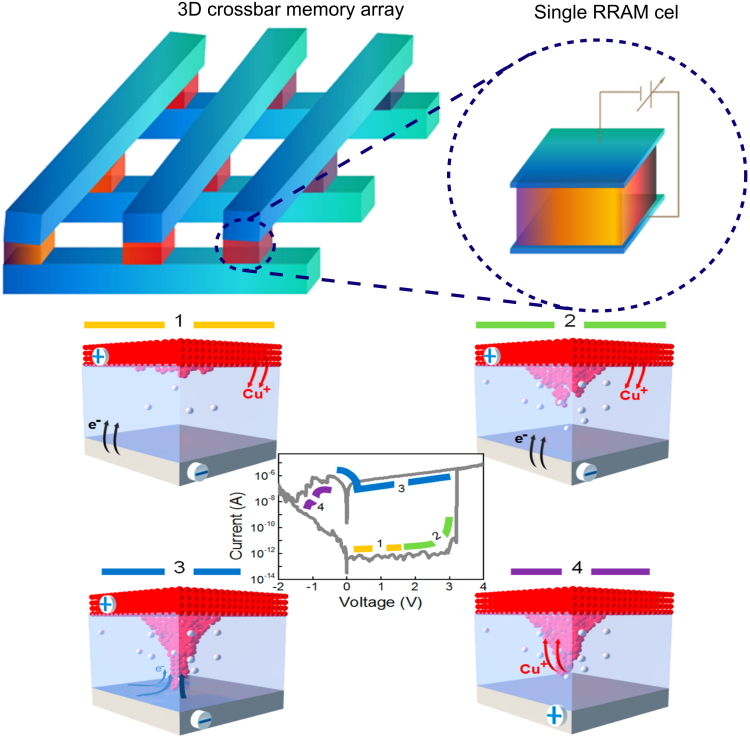Nanoelectronics
Scaling in nanoelectronics devices
Demand for more and faster memory storage capacity has been the driving force in the continuous scaling of memory devices (and electronics in general). However, current memory technology is reaching its scaling limit so new technologies are being investigated to replace or expand them in order to accommodate the ever increasing demand. In resistive memories, the memory cells are switched between a high and low resistive state.
Conductive Bridge RAM
Conductive Bridge RAM (CBRAM) is a novel resistive memory concept where a cell consists of three layers: a cation supply layer (e.g. Cu or Ag rich layer), a dielectric layer (e.g. Al2O3 or SiO2) and an electrochemical inert electrode (e.g. Pt or TiN). The switching is induced by growing/dissolving a conductive filament through the dielectric layer by applying a positive/negative bias on the cation supply layer. Other forms of resistive switching include using amorphous materials and changing them to a crystalline state by means of a voltage induced current. This changes the resistivity of the layer and is known as phase-change memory. A mayor advantage of these novel techniques is that they can be incorporated in new architectures that further increase memory density by stacking layers upon layers of memory cells. One such design is called a 3D cross-bar structure.
Nanoelectronics research at CoCooN
The COCOON group has been involved in research on Cu-Te based cation supply layers (Goux et al., Appl. Phys. Lett., 2011, 99, 053502). Our research focuses on further optimization of this layer and on exploring new materials for application in CBRAM devices. Ongoing research also includes other forms of resistive memory as well as developing materials for selector components which are used in cross-bar structures to eliminate leakage currents.
Publications:
Celano, Umberto, et al. “Three-Dimensional Observation of the Conductive Filament in Nanoscaled Resistive Memory Devices” Nano Letters 14, 5, 2401-2406 (2014). DOI: 10.1021/nl500049g
Goux, Ludovic, et al. “Influence of the Cu-Te composition and microstructure on the resistive switching of Cu-Te/Al2O3/Si cells” APPLIED PHYSICS LETTERS 99, 053502 (2011). DOI: 10.1063/1.3621835
Devulder, Wouter, et al. “Combinatorial Study of Ag-Te Thin Films and Their Application as Cation Supply Layer in CBRAM Cells.” ACS COMBINATORIAL SCIENCE 17, 5 (2015): 334–340. DOI: 10.1021/acscombsci.5b00025
Ahmad, Tareq, et al. “Influence of the Chalcogen Element on the Filament Stability in Culn(Te,Se,S)2/Al2O3 Filamentary Switching Devices.” ACS APPLIED MATERIALS & INTERFACES 10, 17 (2018): 14835–14842. DOI: 10.1021/acsami.7b18228
